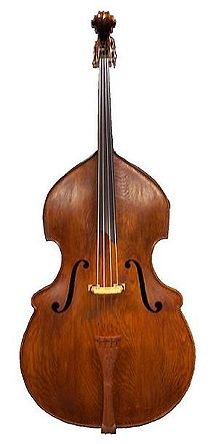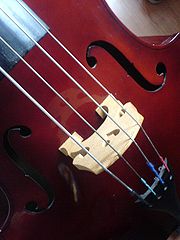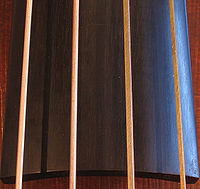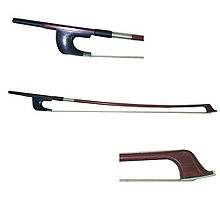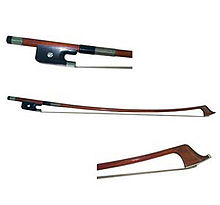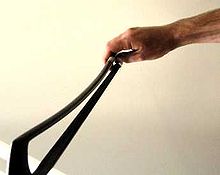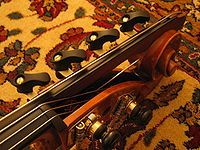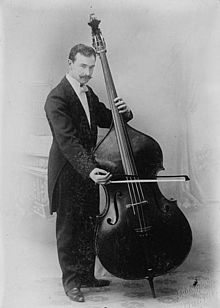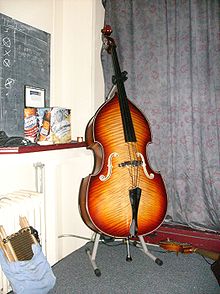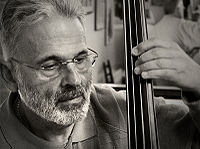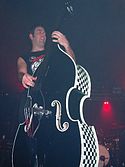- Double bass
-
"Contrabass" redirects here. For other uses, see Contrabass (disambiguation).Not to be confused with Acoustic bass guitar.For the technique used in percussion, see Double bass drum.
Double Bass 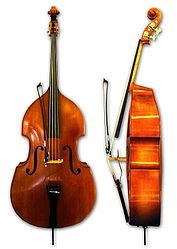
Side and front views of a modern double bass with a French-style bowString instrument Other names Bass, String Bass, Upright Bass, Standup Bass, Acoustic Bass, Contrabass, Bass Violin, Bass Viol, Bass Fiddle, Bull Fiddle, Doghouse, Coffin Bass Classification String instrument (bowed or plucked) Hornbostel–Sachs classification 321.322-71
(Composite chordophone sounded by a bow)Developed 15th century Playing range Related instruments Musicians - List of double bassists
The double bass, also called the string bass, upright bass, standup bass or contrabass, is the largest and lowest-pitched bowed string instrument in the modern symphony orchestra, with strings usually tuned to E1, A1, D2 and G2 (see standard tuning). The double bass is a standard member of the string section of the symphony orchestra[1] and smaller string ensembles[2] in Western classical music. In addition, it is used in other genres such as jazz, 1950s-style blues and rock and roll, rockabilly/psychobilly, traditional country music, bluegrass, tango and many types of folk music. A person who plays the double bass is usually referred to as a bassist.
The double bass stands around 180 cm (six feet) from scroll to endpin,[3] and is typically constructed from several types of wood, including maple for the back, spruce for the top, and ebony for the fingerboard. It is uncertain whether the instrument is a descendant of the viola da gamba or of the violin, but it is traditionally aligned with the violin family. While the double bass is nearly identical in construction to other violin family instruments, it also embodies features found in the older viol family.
Like many other string instruments, the double bass is played either with a bow (arco) or by plucking the strings (pizzicato). In orchestral repertoire and tango music, both arco and pizzicato are employed. In jazz, pizzicato is the norm, except for some solos and also occasional written parts in modern jazz that call for bowing. In most other genres, such as blues and rockabilly, the bass is plucked.
When playing the double bass, the bassist either stands or sits on a high stool and leans the instrument against the bassist's body with the bass turned slightly inwards in order to more easily reach the strings. This stance is also a key reason for the bass' sloped shoulders, which mark it apart from the other members of the violin family, as the narrower shoulders facilitate playing of the strings in their higher registers.
The double bass is a transposing instrument and sounds one octave lower than notated.
History
The double bass is generally regarded as a modern descendant of the string family of instruments that originated in Europe in the 15th century, and as such it has been described as a "bass violin."[4] Before the 20th century many double basses had only three strings, in contrast to the five to six strings typical of instruments in the string family or the four strings of instruments in the violin family. Some existing instruments, such as those by Gasparo da Salò, were converted from 16th-century six-string contrabass violoni.[5]
The double bass's proportions are dissimilar to those of the violin and cello; for example, it is deeper (the distance from top to back is proportionally much greater than the violin). In addition, while the violin has bulging shoulders, most double basses have shoulders carved with a more acute slope, like members of the viol family. Many very old double basses have had their shoulders cut or sloped to aid playing with modern techniques. Before these modifications, the design of their shoulders was closer to instruments of the violin family.
The double bass is the only modern bowed string instrument that is tuned in fourths (like a viol), rather than fifths (see Tuning, below). The issue of the instrument's exact lineage is still a matter of some debate, and the supposition that the double bass is a direct descendant of the viol family is one that has not been entirely resolved.
In his A New History of the Double Bass, Paul Brun asserts, with many references, that the double bass has origins as the true bass of the violin family. He states that, while the exterior of the double bass may resemble the viola da gamba, the internal construction of the double bass is nearly identical to instruments in the violin family, and very different from the internal structure of viols.[6]
Terminology
A person who plays this instrument is called a bassist, double bassist, double bass player, contrabassist, contrabass player, or bass player. The names contrabass and double bass refer the instrument's range and use in the contra octave below the cello, also called the 16' octave relative to the church organ.[7] The terms for the instrument among classical performers are contrabass (which comes from the instrument's Italian name, contrabbasso), string bass (to distinguish it from a brass bass instrument in a concert band), or simply bass.
In jazz and other genres outside of classical music, this instrument is commonly called the upright bass or acoustic bass to distinguish it from the electric bass guitar. In folk and bluegrass music, the instrument is also referred to as a bass fiddle or bass violin (or more rarely as doghouse bass or bull fiddle). Other colourful nicknames are found in other languages; in Hungarian, for instance, the double bass is sometimes called nagy bőgő, which roughly translates as "big crier", referring to its large voice.
Design
In general there are two major approaches to the design outline shape of the double bass, these being the violin form (shown in the labelled picture to the right), and the viol da gamba form (shown in the header picture). A third less common design called the busetto shape can also be found, as can the even more rare guitar or pear shape. The back of the instrument can vary from being a round, carved back similar to that of the violin, or a flat and angled back similar to the viol family.
The double bass features many parts that are similar to members of the violin family including a bridge, f-holes, a tailpiece, a scroll and a sound post. Unlike the rest of the violin family, the double bass still reflects influence and can be considered partly derived from the viol family of instruments, in particular the violone, the bass member of the viol family.
The double bass also differs from members of the violin family in that the shoulders are typically sloped, the back is often angled (both to allow easier access to the instrument, particularly in the upper range), and machine tuners are always fitted. Lack of standardization in design means that one double bass can sound and look very different from another.
Construction
The double bass is closest in construction to violins, but has some notable similarities to the violone (literally "large viol"), the largest and lowest member of the viola da gamba family. Unlike the violone, however, the fingerboard of the double bass is unfretted, and the double bass has fewer strings (the violone, like most viols, generally had six strings, although some specimens had five or four).
An important distinction between the double bass and other members of the violin family is the construction of the pegbox. While the violin, viola, and cello all use friction pegs for gross tuning adjustments, the double bass has metal machine heads. The key on the tuning machine turns a metal "worm", which drives a worm gear that winds the string. While this development makes fine tuners unnecessary, a very small number of bassists use them nevertheless. At the base of the double bass is a metal rod with a spiked end called the endpin, which rests on the floor. This endpin is generally more robust than that of a cello, because of the greater mass of the double bass.
The materials most often used in double-bass construction are maple (back, neck, ribs), spruce (top), and ebony (fingerboard, tailpiece). Exceptions to this include less-expensive basses that have laminated (plywood) tops, backs, and ribs, and some newer mid-range basses made of willow. These basses are resistant to changes in heat and humidity, which can cause cracks in spruce tops. Plywood laminate basses, which are used in music schools, youth orchestras, and in popular and folk music settings, are very resistant to humidity and heat, as well to the physical abuse they are apt to encounter in a school environment (or, for blues and folk musicians, to the hazards of touring and performing in bars).
The soundpost and bass bar are components of the internal construction. All the parts of a double bass are glued together, except the soundpost, bridge and tailpiece, which are held in place by string tension, although the soundpost usually remains in place when the instrument's strings are loosened or removed. The metal tuning machines are attached to the sides of the pegbox with metal screws. While tuning mechanisms generally differ from the higher-pitched orchestral stringed instruments, some basses have non-functional, ornamental tuning pegs projecting from the side of the pegbox, in imitation of the tuning pegs on a cello or violin.
Famous double bass makers come from around the world and often represent varied national characteristics. The most highly sought (and expensive) instruments come from Italy and include basses made by Giovanni Paolo Maggini, Gaspar da Salo, the Testore family (Carlo Antonio, Carlo Giuseppe, Gennaro, Giovanni, Paulo Antonio), Celestino Puolotti, and Matteo Gofriller. French and English basses are also sought by players of the highest caliber.
Strings
The history of the double bass is tightly coupled to the development of string technology, as it was the advent[7] of overwound gut strings which first rendered the instrument more generally practicable, as wound strings attain low notes within a smaller overall string diameter than unwound strings.[8]
Prior to the mid-20th century[citation needed], double bass strings were usually made of gut, but since that time, steel strings have largely replaced gut strings, because steel strings hold their pitch better and yield more volume when played with the bow.[9] Gut strings are also more vulnerable to changes of humidity and temperature, and they break much more easily than steel strings. Gut strings are nowadays mostly used by bassists who perform in baroque ensembles, rockabilly bands, traditional blues bands, and bluegrass bands. Gut strings provide the dark, "thumpy" sound heard on 1940s and 1950s recordings. The late Jeff Sarli, a blues upright bassist, stated that "starting in the 1950s, they began to reset the necks on basses for steel strings", and double bass players switched from gut strings to steel strings.[10] Rockabilly and bluegrass bassists also prefer gut because it is much easier to perform the "slapping" upright bass style (in which the strings are percussively slapped and clicked against the fingerboard) with gut strings than with steel strings. (For more information on slapping, see the sections below on Modern playing styles, Double bass in bluegrass music, Double bass in jazz, and Double bass in popular music).
The change from gut to steel has also affected the instrument's playing technique over the last hundred years, because playing with steel strings allows the strings to be set up closer to the fingerboard, and, additionally, steel strings can be played in higher positions on the lower strings and still produce clear tone. The classic 19th century Franz Simandl method does not utilize the low E string in higher positions because with older gut strings set up high over the fingerboard, the tone was not clear in these higher positions. However, with modern steel strings, bassists can play with clear tone in higher positions on the low E and A strings, particularly when modern lighter-gauge, lower-tension steel strings are used.
Bows
The double bass bow comes in two distinct forms (shown below). The "French" or "overhand" bow is similar in shape and implementation to the bow used on the other members of the orchestral string instrument family, while the "German" or "Butler" bow is typically broader and shorter, and is held in a "hand shake" position.
 French and German bows compared
French and German bows compared
These two bows provide different ways of moving the arm and distributing force on the strings. Proponents of the French bow argue that it is more maneuverable, due to the angle at which the player holds the bow. Advocates of the German bow claim that it allows the player to apply more arm weight on the strings. The differences between the two, however, are minute for a proficient player, and both bows are used by modern players in major orchestras.
German bow
The German bow (sometimes called the Butler bow) is the older of the two designs. The design of the bow and the manner of holding it are descended from the older viol family of instruments. With older viols, before screw threads were used to tighten the bow, players held the bow with two fingers between the stick and the hair to maintain tension of the hair.[11] Proponents of the use of German bow claim that the German bow is easier to use for heavy strokes that require a lot of power.
In comparison with the French bow, the German bow has a taller frog, and it is held with the palm angled upwards, as is done for the upright members of the viol family. When held in correct manner, the thumb applies the necessary power to generate the desired sound. The index finger meets the bow at the point where the frog meets the stick. The index finger is also used to apply an upward torque to the frog when tilting the bow. The little finger (or "pinky") supports the frog from underneath, while the ring finger and middle finger rest in the space between the hair and the shaft.
French bow
The French bow was not widely popular until its adoption by 19th-century virtuoso Giovanni Bottesini. This style is more similar to the traditional bows of the smaller string family instruments. It is held as if the hand is resting by the side of the performer with the palm facing toward the bass. The thumb rests on the shaft of the bow, next to the frog while the other fingers drape on the other side of the bow. Various styles dictate the curve of the fingers and thumb, as do the style of piece; a more pronounced curve and lighter hold on the bow is used for virtuoso or more delicate pieces, while a flatter curve and sturdier grip on the bow sacrifices some power for easier control in strokes such as detaché, spiccato, and staccato.
Bow construction and materials
Double bass bows vary in length, ranging from 60 cm (24") to 75 cm (30"). Pernambuco, also known as Brazilwood, is regarded as an excellent quality stick material, but due to its scarcity and expense, other materials are increasingly being used. Less expensive student bows may be constructed of solid fiberglass, or of less valuable varieties of brazilwood. Snakewood and carbon fiber are also used in bows of a variety of different qualities. The frog of the double bass bow is usually made out of ebony, although Snakewood and buffalo horn are used by some luthiers. The wire wrapping is gold or silver in many quality bows, and the hair is usually horsehair.
The double bass bow is strung with either white or black horsehair, or a combination of the two (known as "salt and pepper"), as opposed to the customary white horsehair used on the bows of other string instruments. Some bassists argue that the slightly rougher black hair "grabs" the heavier, lower strings better.[citation needed] As well, some bassists and luthiers believe that it is easier to produce a smoother sound with the white variety.[citation needed]Red hair (chestnut) is also used by some bassists.[citation needed] Some of the lowest-quality student bows are made with synthetic "hair".
Rosin
String players apply rosin to the bow hair so it will "grip" the string and make it vibrate. Double bass rosin is generally softer and stickier than violin rosin to allow the hair to grab the thicker strings better, but players use a wide variety of rosins that vary from quite hard (like violin rosin) to quite soft, depending on the weather, the humidity, and the preference of the player. The amount used generally depends on the type of music being performed as well as the personal preferences of the player. Bassists may apply more rosin in works for large orchestra (e.g., Brahms symphonies) than for delicate chamber works.[citation needed] Some brands of rosin, such as Pop's double bass rosin, are softer and more prone to melting in hot weather. Other brands, such as Carlsson or Nyman Harts double bass rosin, are harder and less prone to melting.[citation needed]
Pitch
The lowest note of a double bass is an E1 (on standard four-string basses) at approximately 41 Hz or a B0 (when five strings are used) at approximately 31 Hz, within about an octave above the lowest frequency that the average human ear can perceive as a distinctive pitch. The top of the instrument's fingerboard range is typically near the D two octaves and a fifth above the open pitch of the G string (G4) as shown in the range illustration found at the head of this article. Playing beyond the end of the fingerboard can be accomplished by pulling the string slightly to the side.
Many double bass symphony parts and virtuoso concertos employ harmonics (also called flageolet tones). Both natural harmonics and artificial harmonics, where the thumb stops the note and the octave or other harmonic is activated by lightly touching the string at the relative node point, extend the instrument's range considerably.
Orchestral parts rarely demand the double bass exceed a two-octave range (an example of an exception to this rule is Orff's Carmina Burana, which calls for three octaves and a perfect fourth). However, there is no hard limit to the upper range a virtuoso solo player can achieve using natural and artificial harmonics. The high harmonic in the range illustration found at the head of this article may be taken as representative rather than normative.
Five-string instruments have an additional string typically tuned to a low B or low C below the E string. (Orchestral five-string basses are generally tuned to a low C on the fifth string, because the sympathetic resonance from the low C against the higher strings increases the bass' projection more than the low B tuning[citation needed]). Occasionally, a higher string is added instead, tuned to the C above the G string.
Four-string instruments may feature the C extension extending the range of the E string downwards to C.
Traditionally, the double bass is a transposing instrument. Since much of the double bass' range lies below the standard bass clef, it is notated an octave higher than it sounds. This transposition applies even when reading the tenor and treble clef, which are used to avoid excessive ledger lines when notating the instrument's upper range. Other notational traditions do exist; Italian solo music is typically written at the sounding pitch, and the "old" German method sounded an octave below where notation except in the treble clef, where the music was written at pitch.
Tuning
The double bass is generally tuned in fourths, in contrast to members of the orchestral string family, which are tuned in fifths. The standard tuning (low to high) is E-A-D-G, starting from E below second low C (concert pitch). This is the same as the standard tuning of a bass guitar and is one octave lower than the four lowest-pitched strings of standard guitar tuning.
Throughout classical repertoire, there are notes that fall below the range of a standard double bass. Notes below low E appear regularly in the double bass parts found in later arrangements and interpretations of Baroque music. These parts are transpositions of parts written for other bass instruments used before the modern double bass became common and may actually lower the part an octave.
In the Classical era, the double bass typically doubled the cello part an octave below, occasionally requiring descent to C below the E of the four-string double bass. In the Romantic era and the 20th century, composers such as Wagner, Mahler, Beethoven, Busoni, and Prokofiev also requested notes below the low E. There are two common methods for making these notes available to the player. Major European orchestras generally use basses with a fifth string, tuned to B three octaves and a semitone below middle C.[12] Players with standard double basses (E-A-D-G) typically play the notes below "E" an octave higher.
In the United States, Canada and United Kingdom, most professional orchestral players use four-string double basses with a "C extension", which extends the lowest string down as far as low C, an octave below the lowest note on the cello (more rarely, this string may be tuned to a low B[13]). The extension is an extra section of fingerboard mounted up over the head of the bass. There are several varieties of extensions.
In the simplest mechanical extensions, there are no mechanical aids attached to the fingerboard extension except a locking nut for the "E" note. To play the extension notes, the player reaches back over the pegs to press the string to the fingerboard. The advantage of this "fingered" extension is that the player can adjust the intonation of all of the stopped notes on the extension, and there are no mechanical noises from metal keys and levers. The disadvantage of the "fingered" extension is that it can be hard to perform rapid alternations between low notes on the extension and notes on the regular fingerboard, such as a bassline that quickly alternates between "G" and the low "D".
The simplest type of mechanical aid is the use of wooden "fingers" that can be closed to press the string down and fret the C#, D, Eb, or E notes. This system is particularly useful for basslines that have a repeating pedal point such as a low D, because once the note is locked in place with the mechanical "finger", the lowest string then sounds a different note when it is played "open" (e.g., a low D).
The most complicated mechanical aid for use with extensions are mechanical lever systems nicknamed "machines". These lever systems, which superficially resemble the mechanisms of reed instruments such as the bassoon, include levers mounted beside the regular fingerboard (near the nut, on the "E" string side), which remotely activate metal "fingers" on the extension fingerboard. The most expensive metal lever systems also give the player the ability to "lock" down notes on the extension fingerboard, as with the wooden "finger" system. One criticism of these devices is that they may lead to unwanted metallic clicking noises.
A small number of bass players tune their strings in fifths, like a cello but an octave lower (C-G-D-A low to high). This tuning was used by the jazz player Red Mitchell and is increasingly used by classical players, notably the Canadian bassist Joel Quarrington. In classical solo playing the double bass is usually tuned a whole tone higher (F♯-B-E-A). This higher tuning is called "solo tuning", whereas the regular tuning is known as "orchestral tuning." String tension differs so much between solo and orchestral tuning that a different set of strings is often employed that has a lighter gauge. Strings are always labelled for either solo or orchestral tuning, and published solo music is arranged for either solo or orchestral tuning. Some popular solos and concerti, such as the Koussevitsky Concerto are available in both solo and orchestral tuning arrangements.
Many contemporary composers specify highly specialized scordatura. Berio, for example, asks the player to tune his strings E-G#-A-G in Sequenza XIVb and Scelsi asks for both F-A-D-E and F-A-F-E in Nuits.
A variant and much less-commonly used form of solo tuning used in some Eastern European countries is (A-D-G-C), which uses three of the strings from orchestral tuning (A-D-G) and then adds a high "C" string. Some bassists with five-string basses use a high "C" string as the fifth string, instead of a low "B" string. Adding the high "C" string facilitates the performance of solo repertoire with a high tessitura (range). Another option is to utilize both a low C (or B) extension and a high C string.
When choosing a bass with a fifth string, the player must decide between adding a higher or lower-tuned string. Six-stringed instruments are generally regarded as impractical. To accommodate the additional string, the fingerboard is usually slightly wider, and the top slightly thicker to handle the increased tension. Some five-stringed instruments are converted four-string instruments. Because these don't have wider fingerboards, some players find them more difficult to finger and bow. Converted four-string basses usually require either a new, thicker top, or lighter strings to compensate for the increased tension.
Playing and performance considerations
Body and hand position
Double bassists either stand or sit to play the instrument. The instrument height is set by adjusting the endpin such that the player can reach the desired playing zones of the strings with bow or plucking hand.
Bassists who stand and bow sometimes set the endpin by aligning the first finger in either first or half position with eye level, although there is little standardization in this regard.
Players who sit generally use a stool about the height of the player's pants inseam length.
Traditionally, double bassists stood when playing solo and sat when they played in the orchestra or opera pit. Now, playing styles have become specialized to the point where one player rarely can satisfactorily perform both standing and sitting. Consequently, now many soloists sit (as with Joel Quarrington, Jeff Bradetich, Thierry Barbé and others) and orchestras often employ standing bassists.
When playing in the instrument's upper range (above the G below middle C), the player shifts their hand out from behind the neck and flattens it out, using the side of the thumb to press down the string. This technique—also used on the cello—is called thumb position. While playing in thumb position, few players use the fourth (little) finger, as it is too weak to produce a reliable tone (this is also true for cellists), although some extreme chords or extended techniques, especially in contemporary music, may necessitate its use.
Physical considerations
Performing on bass can be physically demanding because the strings are large and thick. Also, the space between notes on the fingerboard is large due to the scale length and string spacing, so players have to shift positions frequently. The bass is usually discouraged for people with shorter arms and smaller hands due to the big note gaps and the thick strings. The increased use of playing techniques such as thumb position and modifications to the bass, such as the use of lighter-gauge strings at lower tension, have eased the difficulty of playing the instrument. Bass parts have relatively fewer fast passages, double stops, or large jumps in range. These parts are usually given to the cello section because it is a smaller instrument and are typically tuned together.
As with all non-fretted string instruments, performers must learn to place their fingers precisely to produce the correct pitch. The more frequent hand movement required by the instrument's size increases the likelihood of intonation errors. For bassists with smaller hands, the large spaces between pitches may present a significant challenge, especially in the lowest range, where the spaces between notes are largest.
Until the 1990s, child-sized double basses were not widely available, and the large size of the bass meant that children were not able to start playing the instrument until their hand size and height would allow them to play a 3/4-size model (the most commonly available size). Starting in the 1990s, smaller half, quarter, eighth and even sixteenth-sized instruments became more widely available, which meant that children could start at a younger age.
Volume
Despite the size of the instrument, it is not as loud as many other instruments due to its low range. In a large orchestra, usually between four and eight bassists play in unison. In the largest orchestras, bass sections may have as many as ten or twelve players, but modern budget constraints make bass sections this large unusual.
When writing solo passages for the bass in orchestral or chamber music, composers typically ensure the orchestration is light so it doesn't obscure the bass. While amplification is rarely used in classical music, in some cases where a bass soloist performs a concerto with a full orchestra, subtle amplification called acoustic enhancement may be used. The use of microphones and amplifiers in a classical setting has led to debate within the classical community, as "...purists maintain that the natural acoustic sound of [Classical] voices [or] instruments in a given hall should not be altered."[14]
In many non-orchestral settings, such as jazz and blues, amplification via a specialized amplifier and loudspeakers is employed. Bluegrass and jazz players typically use less amplification than blues, psychobilly, or jam band players. In the latter cases, the high overall volume due to other amplifiers and instruments may lead to acoustic feedback, a problem exacerbated by the bass's large surface area and interior volume. The feedback problem has led to the development of instruments like the electric upright bass, whose playing characteristics mimic that of the double bass.
Transportation
The double bass's large size and relative fragility make it cumbersome to handle and transport. Most bassists use soft cases, referred to as gig bags, to protect the instrument during transport. Basic, unpadded gig bags used by students cost under 100 USD, while thickly padded gig bags for professional players typically cost as much as 500 USD. Some more feature-filled examples with backpack straps retail for over 1000 USD. Some bassists carry their bow in a hard bow case. Players also may use a small cart or gig bag and end pin-attached wheels to move the bass.
Hard flight cases have cushioned interiors and tough exteriors of carbon fiber, graphite, fiberglass, or Kevlar. The cost of good hard cases—USD 500 to over USD 2500—tends to limit their use to touring professionals.
Classical repertoire
Solo works for double bass
1700s
The double bass as a solo instrument enjoyed a period of popularity during the 18th century and many of the most popular composers from that era wrote pieces for the double bass. The double bass, then often referred to as the Violone used different tunings from region to region. The "Viennese tuning" (A1-D-F♯-A) was popular, and in some cases a fifth string or even sixth string was added (F1-A1-D-F♯-A).[15] The popularity of the instrument is documented in Leopold Mozart's second edition of his Violinschule, where he writes "One can bring forth difficult passages easier with the five-string violone, and I heard unusually beautiful performances of concertos, trios, solos, etc."
The earliest known concerto for double bass was written by Joseph Haydn ca.1763, and is presumed lost in a fire at the Eisenstadt library. The earliest known existing concertos are by Karl Ditters von Dittersdorf, who composed two concertos for the double bass and a Sinfonia Concertante for viola and double bass. Other composers that have written concertos from this period include Johann Baptist Vanhal, Franz Anton Hoffmeister (3 concertos), Leopold Kozeluch, Anton Zimmermann, Antonio Capuzzi, Wenzel Pichl (2 concertos), and Johannes Matthias Sperger (18 concertos). While many of these names were leading figures to the music public of their time, they are generally unknown by contemporary audiences. Wolfgang Amadeus Mozart's concert aria, "Per Questa Bella Mano", K.612 for bass, double bass obbligato, and orchestra contains impressive writing for solo double bass of that period. It remains popular among both singers and double bassists today.
The double bass eventually evolved to fit the needs of orchestras that required lower notes and a louder sound. The leading double bassists from the mid-to-late 18th century, such as Josef Kämpfer, Friedrich Pischelberger, and Johannes Mathias Sperger employed the "Viennese" tuning. Bassist Johann Hindle (1792–1862), who composed a concerto for the double bass, pioneered tuning the bass in fourths, which marked a turning point for the double bass and its role in solo works. Bassist Domenico Dragonetti was a prominent musical figure and an acquaintance of Haydn and Ludwig van Beethoven. His playing was known all the way from his homeland Italy to the Tsardom of Russia and he found a prominent place performing in concerts with the Philharmonic Society of London.
The Italian bass virtuoso Domenico Dragonetti helped to encourage composers to give more difficult parts for his instrument.
Beethoven's friendship with Dragonetti may have inspired him to write difficult, separate parts for the double bass in his symphonies, such as the impressive passages in the third movement of the Fifth Symphony, the second movement of the Seventh Symphony, and last movement of the Ninth Symphony. These parts do not double the cello part. Dragonetti wrote ten concertos for the double bass and many solo works for bass and piano. During Rossini's stay in London in the summer of 1824, he composed his Duetto for cello and double bass for Dragonetti and the cellist David Salomons. Dragonetti frequently played on a three string double bass tuned G-D-A from top to bottom. The use of only the top three strings was popular for bass soloists and Principal bassists in orchestras in the 19th century, because it reduced the pressure on the wooden top of the bass, which was thought to create a more resonant sound. As well, the low "E" strings used during the 19th century were thick cords made of gut, which were difficult to tune and play.
1800s
In the 19th century, the opera conductor, composer, and bassist Giovanni Bottesini was considered the "Paganini of the double bass" of his time. His compositions were written in the popular Italian opera style of the 19th century, which exploit the double bass in a way that was not seen beforehand. They require virtuosic runs and great leaps to the highest registers of the instrument, even into the realm of harmonics. These compositions were considered to be unplayable by many bassists in the early part of the 20th century, but are now frequently performed. During the same time, a prominent school of bass players in the Czech region arose, which included Franz Simandl, Theodore Albin Findeisen, Josef Hrabe, Ludwig Manoly, and Adolf Mišek. Simandl and Hrabe were also pedagogues whose method books and studies continue to be used in modern times.
1900s-present
The leading figure of the double bass in the early 20th century was Serge Koussevitzky, best known as conductor of the Boston Symphony Orchestra, who popularized the double bass in modern times as a solo instrument. Because of improvements to the double bass with steel strings and better set-ups, the bass is now played at a more advanced level than ever before and more and more composers have written works for the double bass. In the mid-century and in the following decades, many new concerti were written for the double bass, including Nikolaos Skalkottas's Concerto (1942), Eduard Tubin's Concerto (1948), Lars-Erik Larsson's Concertino (1957), Gunther Schuller's Concerto (1962), and Hans Werner Henze's Concerto (1966).
From the 1960s through the end of the century Gary Karr was the leading proponent of the double bass as a solo instrument and was active in commissioning or having hundreds of new works and concerti written especially for him. Karr was given Koussevitzky's famous solo doublebass by Olga Koussevitsky and played it in concerts around the world for 40 years before, in turn, giving the instrument to the International Society of Bassists for talented soloists to use in concert. Another important performer in this period, Bertram Turetzky, commissioned and premiered more than 300 double bass works.
In the 1970s and 1980s, new concerti included Nino Rota's Divertimento for Double Bass and Orchestra (1973), Jean Françaix's Concerto (1975), Einojuhani Rautavaara's Angel Of Dusk (1980), Gian Carlo Menotti's Concerto (1983), Christopher Rouse's Concerto (1985), and Henry Brant's Ghost Nets (1988). In the first decade of the 21st century, new concerti include Kalevi Aho's Concerto (2005), John Harbison's Concerto for Bass Viol (2006), and André Previn's Double Concerto for violin, double bass, and orchestra (2007).
Reinhold Glière wrote an Intermezzo and Tarantella for double bass and piano, Op. 9, No. 1 and No. 2 and a Praeludium and Scherzo for double bass and piano, Op. 32 No.1 and No.2. Paul Hindemith wrote a rhythmically challenging Double Bass Sonata in 1949. In the Soviet Union, Mieczysław Weinberg wrote his Sonata No. 1 for double bass solo in 1971. Giacinto Scelsi wrote two double bass pieces called Nuits in 1972, and then in 1976, he wrote Maknongan, a piece for any low-voiced instrument, such as double bass, contrabassoon, or tuba. Vincent Persichetti wrote solo works—which he called "Parables"—for many instruments. He wrote Parable XVII for Double Bass, Op. 131 in 1974. Sofia Gubaidulina penned a Sonata for double bass and piano in 1975. In 1977 Dutch-Hungarian composer Geza Frid wrote a set of variations on The Elephant from Saint-Saëns' Le Carnaval des Animaux for scordatura Double Bass and string orchestra. In 1987 Lowell Liebermann wrote his Sonata for Contrabass and Piano Op.24. Fernando Grillo wrote the "Suite No.1" for double bass (1983/2005). Jacob Druckman wrote a piece for solo double bass entitled Valentine. US double bass soloist and composer Bertram Turetzky (born 1933) has performed and recorded more than 300 pieces written by and for him. He writes chamber music, baroque music, classical, jazz, renaissance music, improvisational music and world music
US minimalist composer Philip Glass wrote a prelude focused on the lower register that he scored for timpani and double bass. Italian composer Sylvano Bussotti, whose composing career spans from the 1930s to the first decade of the 21st century, wrote a solo work for bass in 1983 entitled Naked Angel Face per contrabbasso. Fellow Italian composer Franco Donatoni wrote a piece called Lem for contrabbasso in the same year. In 1989, French composer Pascal Dusapin (born 1955) wrote a solo piece called In et Out for double bass. In 1996, the Sorbonne-trained Lebanese composer Karim Haddad composed Ce qui dort dans l'ombre sacrée ("He who sleeps in the sacred shadows") for Radio France's Presence Festival. Renaud Garcia-Fons (born 1962) is a French double-bass player and composer, notable for drawing on jazz, folk, and Asian music for recordings of his pieces like Oriental Bass (1997). Two significant recent works written for solo bass include, Mario Davidovsky's Synchronisms No.11 for double bass and electronic sounds and Elliott Carter's Figment III, for solo double bass. The German composer Gerhard Stäbler wrote Co-wie Kobalt (1989–90), "a music for double bass solo and grand orchestra". Charles Wuorinen added several important works to the repertoire, Spinoff trio for double bass, violin and conga drums, and Trio for Bass Instruments doublebass, tuba and bass trombone, and in 2007 Synaxis for double bass, horn, oboe and clarinet with timpani and strings.
Chamber music with double bass
Since there is no established instrumental ensemble that includes the double bass, its use in chamber music has not been as exhaustive as the literature for ensembles such as the string quartet or piano trio. Despite this, there is a substantial number of chamber works that incorporate the double bass in both small and large ensembles.
There is a small body of works written for piano quintet with the instrumentation of piano, violin, viola, cello, and double bass. The most famous is Franz Schubert's Piano Quintet in A major, known as "The Trout Quintet" for its set of variations in the fourth movement of Schubert's "Die Forelle". Other works for this instrumentation written from roughly the same period include those by Johann Nepomuk Hummel, George Onslow, Jan Ladislav Dussek, Louise Farrenc, Ferdinand Ries, Franz Limmer, Johann Baptist Cramer, and Hermann Goetz. Later composers who wrote chamber works for this quintet include Ralph Vaughan Williams, Colin Matthews, Jon Deak, Frank Proto, and John Woolrich. Slightly larger sextets written for piano, string quartet, and double bass have been written by Felix Mendelssohn, Mikhail Glinka, Richard Wernick, and Charles Ives.
In the genre of string quintets, there are a few works for string quartet with double bass. Antonín Dvořák's String Quintet in G major, Op.77 and Wolfgang Amadeus Mozart's Serenade in G major, K.525 ("Eine kleine Nachtmusik") are the most popular pieces in this repertoire, along with works by Darius Milhaud, Luigi Boccherini (3 quintets), Harold Shapero, and Paul Hindemith.
Slightly smaller string works with the double bass include six string sonatas by Gioachino Rossini, for two violins, cello, and double bass written at the age of twelve over the course of three days in 1804. These remain his most famous instrumental works and have also been adapted for wind quartet. Franz Anton Hoffmeister wrote four String Quartets for Solo Double Bass, Violin, Viola, and Cello in D Major.
Larger works that incorporate the double bass include Beethoven's Septet in E-flat major, Op.20, one of his most famous pieces during his lifetime, which consists of clarinet, horn, bassoon, violin, viola, cello, and bass. When the clarinetist Ferdinand Troyer commissioned a work from Franz Schubert for similar forces, he added one more violin for his Octet in F major, D.803. Paul Hindemith used the same instrumentation as Schubert for his own Octet. In the realm of even larger works, Mozart included the double bass in addition to 12 wind instruments for his "Gran Partita" Serenade, K.361 and Martinů used the double bass in his nonet for wind quintet, violin, viola, cello and double bass.
Other examples of chamber works that use the double bass in mixed ensembles include Serge Prokofiev's Quintet in G minor, Op.39 for oboe, clarinet, violin, viola, and double bass; Erwin Schulhoff's Concertino for flute/piccolo, viola, and double bass; Fred Lerdahl's Waltzes for violin, viola, cello, and double bass; Mohammed Fairouz's Litany for double bass and wind quartet; Mario Davidovsky's Festino for guitar, viola, cello, and double bass; and Iannis Xenakis's Morsima-Amorsima for piano, violin, cello, and double bass. There are also new music ensembles that utilize the double bass such as Time for Three and PROJECT Trio.
Orchestral passages and solos
The double bass in the baroque and classical periods would typically double the cello part in orchestral passages. A notable exception would be Haydn, who composed solo passages for the double bass in his Symphonies No.6 "Le Matin", No.7 "Le midi", No.8 "Le Soir", No. 31 "Horn Signal", and No. 45 "Farewell", but who otherwise would group the bass and cello parts together. Beethoven paved the way for separate double bass parts, which became more common in the romantic era. The scherzo and trio from Beethoven's Fifth Symphony are famous orchestral excerpts, as is the recitative at the beginning of the fourth movement of Beethoven's Ninth Symphony.
While orchestral bass solos are somewhat rare, there are some notable examples. Johannes Brahms, whose father was a double bass player, wrote many difficult and prominent parts for the double bass in his symphonies. Richard Strauss assigned the double bass daring parts, and his symphonic poems and operas stretch the instrument to its limits. "The Elephant" from Camille Saint-Saëns' The Carnival of the Animals is a satirical portrait of the double bass, and American virtuoso Gary Karr made his televised debut playing "The Swan" (originally written for the cello) with the New York Philharmonic conducted by Leonard Bernstein. The third movement of Gustav Mahler's first symphony features a solo for the double bass that quotes the children's song "Frere Jacques", transposed into a minor key. Sergei Prokofiev's "Lieutenant Kijé Suite" features a difficult and very high double bass solo in the "Romance" movement. Benjamin Britten's The Young Person's Guide to the Orchestra contains a prominent passage for the double bass section.
Double bass ensembles
Ensembles made up entirely of double basses, though relatively rare, also exist, and several composers have written or arranged for such ensembles. Compositions for four double basses exist by Gunther Schuller, Jacob Druckman, James Tenney, Robert Ceely, Jan Alm, Bernhard Alt, Norman Ludwin, Frank Proto, Joseph Lauber, Erich Hartmann, Colin Brumby, Miloslav Gajdos and Theodore Albin Findeisen. Bertold Hummel wrote a Sinfonia piccola [2] for eight double basses. Larger ensemble works include Galina Ustvolskaya's Composition No. 2, "Dies Irae" (1973), for eight double basses, piano, and wooden cube, Jose Serebrier's George and Muriel (1986), for solo bass, double bass ensemble, and chorus, and Gerhard Samuel's What of my music! (1979), for soprano, percussion, and 30 double basses.
Active double bass ensembles include L'Orchestre de Contrebasses (6 members),[16] Bass Instinct (6 members),[17] Bassiona Amorosa (6 members),[18] the Chicago Bass Ensemble (4+ members),[19] The Bass Gang (4 members),[20] the London Double Bass Ensemble (6 members) founded by members of the Philharmonia Orchestra of London who produced the LP[21]Music Interludes by London Double Bass Ensemble on Bruton Music records, Brno Double Bass Orchestra (14 members) founded by the double bass professor at Janáček Academy of Music and Performing Arts and principal double bass player at Brno Philharmonic Orchestra - Miloslav Jelinek, and the ensembles of Ball State University (12 members), Shenandoah Conservatory, and the Hartt School of Music. The Amarillo Bass Base of Amarillo, Texas once featured 52 double bassists,[22][23] and The London Double Bass Sound, who have released a CD on Cala Records, have 10 players.[24]
In addition, the double bass sections of some orchestras perform as an ensemble, such as the Chicago Symphony Orchestra's Wacker Consort.[25] There is an increasing number of published compositions and arrangements for double bass ensembles, and the International Society of Bassists regularly features double bass ensembles (both smaller ensembles as well as very large "mass bass" ensembles) at its conferences, and sponsors the biennial David Walter Composition Competition, which includes a division for double bass ensemble works.
Use in jazz
See also List of jazz bassists (which includes both upright bass and electric bass guitar players)
Beginning around 1890, the early New Orleans jazz ensemble (which played a mixture of marches, ragtime, and Dixieland) was initially a marching band with a tuba or sousaphone (or occasionally bass saxophone) supplying the bass line. As the music moved into bars and brothels, the upright bass gradually replaced these wind instruments. Many early bassists doubled on both the "brass bass" and "string bass", as the instruments were then often referred to. Bassists played "walking" bass lines—scale-based lines that outlined the harmony.
Because an unamplified upright bass is generally the quietest instrument in a jazz band, many players of the 1920s and 1930s used the slap style, slapping and pulling the strings so that they make a rhythmic "slap" sound against the fingerboard. The slap style cuts through the sound of a band better than simply plucking the strings, and allowed the bass to be more easily heard on early sound recordings, as the recording equipment of that time did not favor low frequencies.[26] For more about the slap style, see "Modern playing styles", below.
Many upright bass players have contributed to the evolution of jazz. Examples include swing era players such as Jimmy Blanton, who played with Duke Ellington, and Oscar Pettiford, who pioneered the instrument's use in bebop. Paul Chambers (who worked with Miles Davis on the famous Kind of Blue album) achieved renown for being one of the first jazz bassists to play bebop solos with the bow. Terry Plumeri furthered the development of arco (bowed) solos, achieving horn-like technical freedom and a clear, vocal bowed tone, while Charlie Haden, best known for his work with Ornette Coleman, defined the role of the bass in Free Jazz.
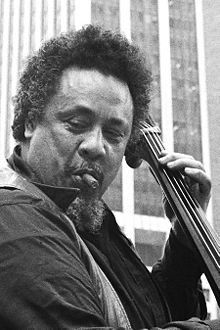 Jazz bassist Charles Mingus was also an influential bandleader and composer whose musical interests spanned from bebop to free jazz.
Jazz bassist Charles Mingus was also an influential bandleader and composer whose musical interests spanned from bebop to free jazz.
A number of other bassists, such as Ray Brown and Slam Stewart, were central to the history of jazz. Notably, Charles Mingus was a highly regarded composer as well as a bassist noted for his technical virtuosity and powerful sound.[27] Scott LaFaro influenced a generation of musicians by liberating the bass from contrapuntal "walking" behind soloists instead favoring interactive, conversational melodies.[28]
While the electric bass guitar was used intermittently in jazz as early as 1951, beginning in the 1970s bassist Bob Cranshaw, playing with saxophonist Sonny Rollins, and fusion pioneers Jaco Pastorius and Stanley Clarke began to commonly substitute the bass guitar for the upright bass. Apart from the jazz styles of jazz fusion and Latin-influenced jazz however, the upright bass is still the dominant bass instrument in jazz. The sound and tone of the plucked upright bass is distinct from that of the fretted bass guitar. The upright bass produces a different sound than the bass guitar, because its strings are not stopped by metal frets, instead having a continuous tonal range on the uninterrupted fingerboard. As well, bass guitars usually have a solid wood body, which means that their sound is produced by electronic amplification of the vibration of the strings, instead of the upright bass' acoustic reverberation.
The string bass is the most commonly used bass instrument in bluegrass music and is almost always plucked, though some modern bluegrass bassists have also used a bow. The bluegrass bassist is part of the rhythm section, and is responsible for keeping a steady beat, whether fast, slow, in 4/4 time, 2/4 or 3/4 time. The Engelhardt-Link (formerly Kay) brands of laminate basses have long been popular choices for bluegrass bassists. Most bluegrass bassists use the 3/4 size bass, but the full-size and 5/8 size basses are also used.
Early pre-bluegrass traditional music was often accompanied by the cello. The cellist Natalie Haas points out that in the US, you can find "... old photographs, and even old recordings, of American string bands with cello." However, "the cello dropped out of sight in folk music and became associated with the orchestra".[29] The cello did not reappear in bluegrass until the 1990s and first decade of the 21st century. Some contemporary bluegrass bands favor the electric bass, because it is easier to transport than the large and somewhat fragile upright bass. However, the bass guitar has a different musical sound. Many musicians feel the slower attack and percussive, woody tone of the upright bass gives it a more "earthy" or "natural" sound than an electric bass, particularly when gut strings are used.
Common rhythms in bluegrass bass playing involve (with some exceptions) plucking on beats 1 and 3 in 4/4 time; beats 1 and 2 in 2/4 time, and on the downbeat in 3/4 time (waltz time). Bluegrass bass lines are usually simple, typically staying on the root and fifth of each chord throughout most of a song. There are two main exceptions to this "rule". Bluegrass bassists often do a diatonic "walkup" or "walkdown" in which they play every beat of a bar for one or two bars, typically when there is a chord change. In addition, if a bass player is given a solo, they may play a walking bass line with a note on every beat or play a pentatonic scale-influenced bassline.
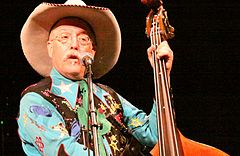 Country music bassist "Too Slim" (Fred LaBour of Riders in the Sky) performing in Ponca City, Oklahoma in 2008.
Country music bassist "Too Slim" (Fred LaBour of Riders in the Sky) performing in Ponca City, Oklahoma in 2008.
An early bluegrass bassist to rise to prominence was Howard Watts (also known as Cedric Rainwater), who played with Bill Monroe's Blue Grass Boys beginning in 1944.[30] The classical bassist Edgar Meyer has frequently branched out into newgrass, old-time, jazz, and other genres. "My all-time favorite is Todd Phillips", proclaimed Union Station bassist Barry Bales in April 2005. "He brought a completely different way of thinking about and playing bluegrass.
An upright bass was the standard bass instrument in traditional country western music. While the upright bass is still occasionally used in country music, the electric bass has largely replaced its bigger cousin in country music, especially in the more pop-infused country styles of the 1990s and 2000s, such as new country.
Slap-style bass
Slap-style bass is sometimes used in bluegrass bass playing. When bluegrass bass players slap the string by pulling it until it hits the fingerboard or hit the strings against the fingerboard, it adds the high-pitched percussive "clack" or "slap" sound to the low-pitched bass notes, sounding much like the clacks of a tap dancer. Slapping is a subject of minor controversy in the bluegrass scene. Even slapping experts such as Mike Bub say, "...don't slap on every gig" or in songs where it is "not appropriate." As well, bluegrass bassists who play slap-style on live shows often slap less on records. Bub and his mentor Jerry McCoury rarely do slap bass on recordings. While bassists such as Jack Cook slap bass "...on the occasional faster Clinch Mountain boys song", bassists such as "...Gene Libbea, Missy Raines, Jenny Keel, or Barry Bales [rarely] slap bass."[31]
Bluegrass bassist Mark Schatz, who teaches slap bass in his Intermediate Bluegrass Bass DVD acknowledges that slap bass "...has not been stylistically very predominant in the music I have recorded." He notes that "Even in traditional bluegrass slap bass only appears sporadically and most of what I've done has been on the more contemporary side of that (Tony Rice, Tim O'Brien)." Schatz states that he would be "... more likely to use it [slap] in a live situation than on a recording – for a solo or to punctuate a particular place in a song or tune where I wouldn't be obliterating someone's solo.".[32] Another bluegrass method, Learn to Play Bluegrass Bass, by Earl Gately, also teaches bluegrass slap bass technique.
Use in popular music
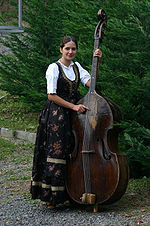 Double bass player from the Bunjevac minority group in Hungary.
Double bass player from the Bunjevac minority group in Hungary.
In 1952, the upright bass was a standard instrument in rock and roll music, Marshall Lytle of Bill Haley & His Comets being but one example. In the 1940s, a new style of dance music called rhythm and blues developed, incorporating elements of the earlier styles of blues and swing. Louis Jordan, the first innovator of this style, featured a upright bass in his group, the Tympany Five.[33] The upright bass remained an integral part of pop lineups throughout the 1950s, as the new genre of rock and roll was built largely upon the model of rhythm and blues, with strong elements also derived from jazz, country, and bluegrass. However, upright bass players using their instruments in these contexts faced inherent problems. They were forced to compete with louder horn instruments (and later amplified electric guitars), making bass parts difficult to hear. The upright bass is difficult to amplify in loud concert venue settings, because it can be prone to feedback "howls". The upright bass is large and awkward to transport, which also created transportation problems for touring bands. In some groups, the slap bass was utilized as band percussion in lieu of a drummer; such was the case with Bill Haley & His Saddlemen (the forerunner group to the Comets), which did not use drummers on recordings and live performances until late 1952; prior to this the slap bass was relied on for percussion, including on recordings such as Haley's versions of Rock the Joint and Rocket 88.[34]
In 1951, Leo Fender independently released his Precision Bass, the first commercially successful electric bass guitar.[35] The electric bass was easily amplified with its built-in pickups, easily portable (less than a foot longer than an electric guitar), and easier to play in tune, thanks to the metal frets. In the 1960s and 1970s bands were playing at louder volumes and performing in larger venues. The electric bass was able to provide the huge, highly amplified stadium-filling bass tone that the pop and rock music of this era demanded, and the upright bass receded from the limelight of the popular music scene.
The upright bass began making a modest comeback in popular music in the mid-1980s, in part due to a renewed interest in earlier forms of rock and country music. In the 1990s, improvements in pickups and amplifier designs for electro-acoustic horizontal and upright basses made it easier for bassists to get a good, clear amplified tone from an acoustic instrument. Some popular bands decided to anchor their sound with an upright bass instead of an electric bass. A trend for "unplugged" performances further helped to enhance the public's interest in the upright bass and acoustic bass guitars.
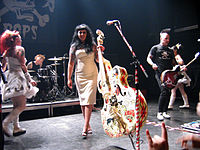 The bassist for psychobilly band The HorrorPops, seen here at a 2006 show, uses a colorful, custom-painted upright bass with a cutaway upper shoulder for easier access to the higher positions.
The bassist for psychobilly band The HorrorPops, seen here at a 2006 show, uses a colorful, custom-painted upright bass with a cutaway upper shoulder for easier access to the higher positions.
Peter Steele, bassist/vocalist for the gothic metal band Type O Negative, was renowned for occasionally playing an upright bass held like a guitar. This feat was made possible only by his considerable height (6'8").
The upright bass is also favored over the electric bass guitar in many rockabilly and psychobilly bands. In such bands the bassist often plays with great showmanship, using slapping technique, sometimes spinning the bass around or even physically climbing onto the instrument while performing; this style was pioneered c. 1953 by Marshall Lytle, the bassist for Bill Haley & His Comets,[36] and modern performers of such stunts include Lee Rocker of the Stray Cats, Phil Bloomberg of The Polecats, Scott Owen from The Living End and Jimbo Wallace from The Reverend Horton Heat. Primus's Les Claypool used an upright bass for the song "Mr. Krinkle", from Pork Soda, and for the song "Over the Falls", from the Brown Album.
Athol Guy of the Australian folk/pop group The Seekers plays an upright bass. Shannon Burchell, of the Australian folk-rock group The John Butler Trio,[37] makes extensive use of upright basses, performing extended live solos in songs such as Betterman. On the 2008 album In Ear Park by the indie/pop band Department of Eagles, a bowed upright bass is featured quite prominently on the songs "Teenagers" and "In Ear Park". Norwegian ompa-rock band Kaizers Orchestra use the upright bass exclusively both live and on their recordings.[38]
Hank Williams III's bass players (Joe Buck and Zach Shedd, most notably) have used upright basses for recording as well as during the country and Hellbilly sets of Hank III's live performances before switching to electric bass for the Assjack set.
Modern playing styles
In popular music genres, the instrument is usually played with amplification and almost exclusively played with the fingers, pizzicato style. The pizzicato style varies between different players and genres. Some players perform with the sides of one, two, or three fingers, especially for walking basslines and slow tempo ballads, because this is purported to create a stronger and more solid tone. Some players use the more nimble tips of the fingers to play fast-moving solo passages or to pluck lightly for quiet tunes.The use of amplification allows the player to have more control over the tone of the instrument, because amplifiers have equalization controls that allow the bassist to accentuate certain frequencies (often the bass frequencies) while de-accentuating some frequencies (often the high frequencies, so that there is less finger noise).
An unamplified acoustic bass' tone is limited by the frequency responsiveness of the instrument's hollow body, which means that the very low pitches may not be as loud as the higher pitches. With an amplifier and equalization devices, a bass player can boost the low frequencies, which evens out the frequency response. In addition, the use of an amplifier can increase the sustain of the instrument, which is particularly useful for accompaniment during ballads and for melodic solos with held notes.
In traditional jazz, swing, polka, rockabilly, and psychobilly music, it is sometimes played in the slap style. This is a vigorous version of pizzicato where the strings are "slapped" against the fingerboard between the main notes of the bass line, producing a snare drum-like percussive sound. The main notes are either played normally or by pulling the string away from the fingerboard and releasing it so that it bounces off the fingerboard, producing a distinctive percussive attack in addition to the expected pitch. Notable slap style bass players, whose use of the technique was often highly syncopated and virtuosic, sometimes interpolated two, three, four, or more slaps in between notes of the bass line.
"Slap style" may have influenced electric bass guitar players who from the mid-sixties (particularly Larry Graham of Sly and the Family Stone) developed a technique called "slap and pop", where the thumb of the plucking hand is used to hit the string, making a slapping sound but still allowing the note to ring, and the index or middle finger of the plucking hand is used to pull the string back so it hits the fretboard, achieving the pop sound described above.
Double bassists
Historical
- Domenico Dragonetti (1763–1846) Virtuoso, composer, conductor
- Giovanni Bottesini (1821–1889) Virtuoso, composer, conductor
- Franz Simandl (1840–1912) Virtuoso, composer, pedagogue
- Edouard Nanny (1872–1943) Virtuoso, composer
- Serge Koussevitzky (1874–1951) Virtuoso, composer, conductor
Contemporary (1900s-present)
Classical
Some of the most influential contemporary classical double bass players are known as much for their contributions to pedagogy than for their performing skills, such as US bassist Oscar G. Zimmerman (1910–1987), known for his teaching at the Eastman School of Music and, for 44 summers at the Interlochen National Music Camp in Michigan and French bassist François Rabbath (b. 1931) who developed a new bass method that divided the entire fingerboard into six positions. Bassists noted for their virtuoso solo skills include Canadian player Gary Karr (b. 1941), Finnish composer Teppo Hauta-Aho (b. 1941), Italian composer Fernando Grillo, and US player-composer Edgar Meyer. For a longer list, see the List of contemporary classical double bass players.
Jazz
Notable jazz bassists from the 1940s to the 1950s included bassist Jimmy Blanton (1918–1942) whose short tenure in the Duke Ellington Swing band (cut short by his death from tuberculosis) introduced new melodic and harmonic solo ideas for the instrument; bassist Ray Brown (1926–2002), known for backing Beboppers Dizzy Gillespie, Oscar Peterson, Art Tatum and Charlie Parker, and forming the Modern Jazz Quartet; hard bop bassist Ron Carter (born 1937), who has appeared on 3,500 albums make him one of the most-recorded bassists in jazz history, including LPs by Thelonious Monk and Wes Montgomery and many Blue Note Records artists; and Paul Chambers (1935–1969), a member of the Miles Davis Quintet (including the landmark modal jazz recording Kind of Blue) and many other 1950s and 1960s rhythm sections, was known for his virtuosic improvisations.
In the experimental post 1960s eras, which saw the development of free jazz and jazz-rock fusion, some of the influential bassists included Charles Mingus (1922–1979), who was also a composer and bandleader whose music fused hard bop with black gospel music, free jazz and classical music; free jazz and post-bop bassist Charlie Haden (born 1937) is best known for his long association with saxophonist Ornette Coleman and for his role in the 1970s-era Liberation Music Orchestra, an experimental group; Eddie Gomez and George Mraz, who played with Bill Evans and Oscar Peterson, respectively, and are both acknowledged to have furthered expectations of pizzicato fluency and melodic phrasing, fusion virtuoso Stanley Clarke (born 1951) is notable for his dexterity on both the upright bass and the electric bass, and Terry Plumeri, noted for his horn-like arco fluency and vocal tone. In the 1990s and first decade of the 21st century, one of the new "young lions" was Christian McBride (born 1972), who has performed with a range of veterans ranging from McCoy Tyner to fusion gurus Herbie Hancock and Chick Corea, and who has released albums such as 2003's Vertical Vision. For a longer list, see the List of jazz bassists, which includes both double bass and electric bass players.
Other popular genres
In addition to being a noted classical player, Edgar Meyer is well known in bluegrass and newgrass circles. Todd Phillips is another prominent bluegrass player. Well-known rockabilly bassists include Bill Black, Marshall Lytle (with Bill Haley & His Comets) and Lee Rocker (with 1980s-era rockabilly revivalists the Stray Cats). Notable rockabilly revivalists and psychobilly performers from the 1990s and first decade of the 21st century include Scott Owen (from the Australian band The Living End), Jimbo Wallace (from the US band Reverend Horton Heat), Kim Nekroman (Nekromantix), Patricia Day (HorrorPops), Geoff Kresge (Tiger Army, ex-AFI). Willie Dixon (1915–1992) was one of the most notable figures in the history of rhythm and blues. In addition to being an upright bassist, he wrote dozens of R&B hits and worked as a producer. He also plays bass on numerous Chuck Berry's rock and roll hits. Many other rockabilly bands like El Rio Trio (from the Netherlands) also use this instrument in their work.
Pedagogy and training
The pedagogy and training for the double bass varies widely by genre and country. Classical double bass has a history of pedagogy dating back several centuries, including teaching manuals, studies, and progressive exercises that help students to develop the endurance and accuracy of the left hand, and control for the bowing hand. Classical training methods vary by country: many of the major European countries are associated with specific methods (e.g., the Edouard Nanny method in France or the Franz Simandl method in Germany). In classical training, the majority of the instruction for the right hand focuses on the production of bowing tone; little time is spent studying the varieties of pizzicato tone.
In contrast, in genres that mainly or exclusively use pizzicato (plucking), such as jazz and blues, a great deal of time and effort is focused on learning the varieties of different pizzicato styles used for music of different styles of tempi. For example, in jazz, aspiring bassists have to learn how to perform a wide range of pizzicato tones, including using the sides of the fingers to create a full, deep sound for ballads, using the tips of the fingers for fast walking basslines or solos, and performing a variety of percussive "ghost notes" by "raking" muted or partially muted strings.
Formal training
Of all of the genres, classical and jazz have the most established and comprehensive systems of instruction and training. In the classical milieu, children can begin taking private lessons on the instrument and performing in children's or youth orchestras. Teens who aspire to becoming professional classical bassists can continue their studies in a variety of formal training settings, including colleges, conservatories, and universities. Colleges offer certificates and diplomas in bass performance.
Conservatories, which are the standard musical training system in France and in Quebec (Canada) provide lessons and amateur orchestral experience for double bass players. Universities offer a range of double bass programs, including Bachelor's degrees, Master of Music degrees, and Doctor of Musical Arts degrees. As well, there are a variety of other training programs such as classical summer camps and orchestral, opera, or chamber music training festivals, which give students the opportunity to play a wide range of music.
Bachelor's degrees in bass performance (referred to as B.Mus. or B.M) are four-year programs that include individual bass lessons, amateur orchestra experience, and a sequence of courses in music history, music theory, and liberal arts courses (e.g., English literature), which give the student a more well-rounded education. Usually, bass performance students perform several recitals of solo double bass music, such as concertos, sonatas, and Baroque suites.
Master of music degrees in double bass performance consist of private lessons, ensemble experience, coaching in playing orchestral double bass parts, and graduate courses in music history and music theory, along with one or two solo recitals. A Master's degree in music (referred to as an M.Mus. or M.M.) is often a required credential for people who wish to become a professor of double bass at a university or conservatory.
Doctor of Musical Arts (referred to as D.M.A., DMA, D.Mus.A. or A.Mus.D) degrees in double bass performance provide an opportunity for advanced study at the highest artistic and pedagogical level, requiring usually an additional 54+ credit hours beyond a Master's degree (which is about 30+ credits beyond a Bachelor's degree). For this reason, admission to candidacy is highly selective. Examinations in music history, music theory, ear training/dictation, plus an entrance examination/recital, are required to enter such a program of study. A number of recitals (around six), including a lecture-recital for which an accompanying doctoral dissertation is submitted, advanced coursework and a minimum B average are other typical requirements of a D.M.A program.
Throughout the early history of jazz, double bass players either learned the instrument informally, or from getting classical training early on, as in the case of Ron Carter and Charles Mingus. In the 1980s and 1990s, colleges and universities began to introduce diplomas and degrees in jazz performance. Students in jazz diploma or Bachelor of Music programs take individual bass lessons, get experience in small jazz combos with coaching from an experienced player, and play in jazz big bands. As with classical training programs, jazz programs also include classroom courses in music history and music theory. In a jazz program, these courses focus on the different eras of jazz history. such as Swing, Bebop, and fusion. The theory courses focus on the musical skills used in jazz improvisation and in jazz "comping" (accompanying) and the composition of jazz tunes. There are also jazz summer camps and training festivals/seminars, which offer students the chance to learn new skills and styles.
Informal training
In other genres, such as blues, rockabilly, and psychobilly, the pedagogical systems and training sequences are not as formalized and institutionalized. There are not degrees in blues bass performance, or conservatories offering multiple-year diplomas in rockabilly bass. However, there are a range of books, playing methods, and, since the 1990s, instructional DVDs (e.g., on how to play rockabilly-style slap bass). As such, performers in these other genres tend to come from a variety of routes, including informal learning by using bass method books or DVDs, taking private lessons and coaching, and learning from records and CDs. In some cases, blues or rockabilly bassists may have obtained some initial training through the classical or jazz pedagogy systems (e.g., youth orchestra or high school big band). In genres such as tango, which use a lot of bowed passages and jazz-style pizzicato lines. the bassists tend to come from classical or jazz training routes.
Careers
Careers in double bass vary widely by genre and by region or country. Most bassists earn their living from a mixture of performance and teaching jobs. The first step to getting most performance jobs is by playing at an audition. In some styles of music, such as jazz-oriented stage bands, bassists may be asked to sight read printed music or perform standard pieces (e.g., a jazz standard such as "Now's the Time") with an ensemble. Similarly, in a rock or blues band, auditionees may be asked to play various rock or blues standards. An upright bassist auditioning for a blues band might be asked to play in a Swing-style walking bassline, a rockabilly-style "slapping" bassline (in which the strings are percussively struck against the fingerboard) and a 1950s ballad with long held notes. A person auditioning for a role as a bassist in some styles of pop or rock music may be expected to be able to demonstrate the ability to perform harmony vocals as a backup singer.
In classical music, bassists do auditions to get playing jobs in orchestras and to get into university or Conservatory programs or degrees. At a classical bass audition, the performer typically plays a movement from a Bach suite or a movement from a bass concerto and a variety of excerpts from the orchestral literature. Orchestral bass auditions are typically held in front of a panel that includes the conductor, the Concertmaster, the Principal bass player, and possibly other principal players such as the Principal cellist. The most promising candidates are invited to return for a second or third round of auditions, which allows the conductor and the panel to compare the best candidates. Performers may be asked to sight read orchestral music. The final stage of the audition process in some orchestras is a "test week", in which the performer plays with the orchestra for a week or two, which allows the conductor and Principal players to see if the individual can function well in an actual performance setting.
Performance jobs include playing as a freelancer in small groups, large ensembles, or performing solo music, either live onstage or as a "session player" for radio or TV broadcasts or for recordings; and working as the employee of an orchestra, big band, or recording studio (as the studio's "house bassist"). Many bass players find extra work by substituting ("subbing") for bassists who are double-booked or ill. It is hard for bass players to be able to find full-time, full-year work at a single job. About the closest that a bass player can come to this is in the case of classical bass players who win an audition at a professional orchestra or the tiny number of top session pros that are hired by recording studios. Even full-time orchestra jobs do not usually last for the entire year. When the orchestra stops playing (which is often in the summer), orchestral bassists have to find other work, either as a teacher or coach, or in another group.
Teaching work for double bassist includes giving private lessons in the home or at colleges and universities; coaching bass players who are preparing for recordings or auditions; doing group coaching at music camps or for youth ensembles; and working as a high school music teacher.
In jazz, blues, rockabilly and other genres, most bassists cannot earn a living from playing in a single group (with the exception of a the small number of bassists in top touring bands or groups with recording contracts), so they work in different bands, and supplement their income with session playing and teaching. Due to the limited number of full-time orchestral jobs, many classical bassists are similarly not able to find full-time work with a single orchestra. Some bassists increase their employability by learning several different styles, such as classical and jazz or rockabilly and bluegrass.
In some cases, bassists supplement their performing and teaching income with other related music jobs, such as working as a bass repairer (luthier); acting as a contractor who hires musicians for orchestras or big bands. composing music (e.g., Dave Holland), songwriting, conducting (e.g., David Currie), or acting as a bandleader (e.g., Charles Mingus). In some regions, there may not be enough work in music to make a living, even if a bassist can play several styles and he or she does recordings and teaching. As such, in some regions, bassists may have to supplement their musical work with income from another field outside of music.
See also
- Electric upright bass
- List of jazz bassists
- List of historical classical double bass players
- List of contemporary classical double bass players
- List of double bass concerti
- Octobass
- Piccolo bass
- Bach: Unaccompanied Cello Suites Performed on Double Bass
- International Society of Bassists
- Bazantar
- Cello, the second largest bowed string instrument
References
- ^ The Orchestra: A User's Manual, Andrew Hugill with the Philharmonia Orchestra
- ^ Chamber Music in the Vienna Double Bass Archive, Alfred Planyavsky
- ^ Double Bass Sizing FAQ, Bob Gollihur
- ^ The Double Bass, Jacob Head
- ^ Planyavsky 1998
- ^ A New History of the Double Bass, Paul Brun
- ^ a b A Brief History of the Double Bass, Lawrence Hurst, Professor of Double Bass, School of Music, Indiana University
- ^ Strings, standing waves and harmonics, Prof. Joe Wolfe, University of New South Wales
- ^ Article on bass strings by the Double Bass Workshop
- ^ Jeff Sarli
- ^ [1]
- ^ Bill Bentgen – 5 String Basses
- ^ A few works in the orchestral repertoire call for a low "B", including Respighi's The Pines of Rome
- ^ Sound Systems- Why?!
- ^ David Chapman. "Historical and Practical Considerations for the Tuning of Double Bass Instruments in Fourths", p.228-229, The Galpin Society Journal, Vol. 56, (Jun., 2003), pp. 224–233.
- ^ Official website of L'Orchestre de Contrebasses
- ^ LOVEFiLM.com: Bass Instinct – Live In Vienna by none on DVD
- ^ www.bassiona-amorosa.de
- ^ Chicago Bass Ensemble – Home
- ^ The Bass Gang, The Bass Gang, The Bass Gang, The Bass Gang, The Bass Gang,The Bass Gang
- ^ Music Interludes
- ^ http://home.mchsi.com/~donovan.stokes/volumeone.html
- ^ http://www.bassgirls.com/bass_wyrickinez.htm
- ^ Amazon.com: The London Double Bass Sound: Gary Karr, Ernest Bloch, Paul Desmond, Edward "Duke" Ellington, Jerome Kern, John & Paul McCartney Lennon, Niccolo Paganini, Cole Por...
- ^ Wacker Consort and Northwestern Music Faculty to Perform, NewsCenter, Northwestern University
- ^ Historic Jazz Fotos
- ^ Nat Hentoff, Gadfly Online, April 1999, http://www.gadflyonline.com/archive/April99/archive-mingus.html, retrieved 3 November 2009.
- ^ Jazz Improv Magazine, http://www.jazzimprov.com/links/legends.cfm?legend_id=12, retrieved 3 November 2009. Scott Yanow, AllMusic Guide, http://www.allmusic.com/artist/p95770 retrieved 3 November 2009.
- ^ Looming Large: What's a cello got to do with a famous fiddler's tale? By Natalie Haas. Available at: http://www.allthingsstrings.com/article/default.aspx?articleid=21495
- ^ Howard "Cedric Rainwater" Watts, Stewart Evans
- ^ iBluegrass.com Article: The Low End February-02-2001 ©2001 iBluegrass.com. All rights reserved. By Kip Martin http://72.14.205.104/search?q=cache:opbTh79jK-8J:www.ibluegrass.com/vi_posting3.CFM%3Fp__i%3D1004%26p__r%3D%26p__a%3Dbass+bluegrass+%22slap+bass%22&hl=en&ct=clnk&cd=2
- ^ http://72.14.205.104/search?q=cache:0bSxq7Zh3tYJ:www.rockabillybass.com/markschatz.htm+bluegrass+%22slap+bass%22&hl=en&ct=clnk&cd=1
- ^ Dallas Bartley – Small town Boy: Playing in the bands, Special Collections and Archives Department, Missouri State University
- ^ BBC Radio 2, Just Keep on Rockin' , broadcast 17 April 2004. On this radio documentary, host Suzi Quatro expresses disbelief that no drums were utilized on the recording of "Rock the Joint".
- ^ The Electric Guitar: How We Got From Andrés Segovia To Kurt Cobain, Monica M. Smith
- ^ Marshall Lytle: Granddaddy of the Doghouse, Rod Glaze
- ^ "In Australia, the John Butler Trio has established itself as one of the most successful independent acts in recent history. Their U.S. debut, Sunrise Over Sea, features gritty and soulful vocals, elements of hip-hop and Appalachian folk."http://www.npr.org/templates/story/story.php?storyId=4814948
- ^ Kaizers Orchestra official web page
External links
Categories:- Double-bassists
- Bowed instruments
- Continuous pitch instruments
- Contrabass instruments
- String instruments
- Bass (sound)
- Double basses
Wikimedia Foundation. 2010.


